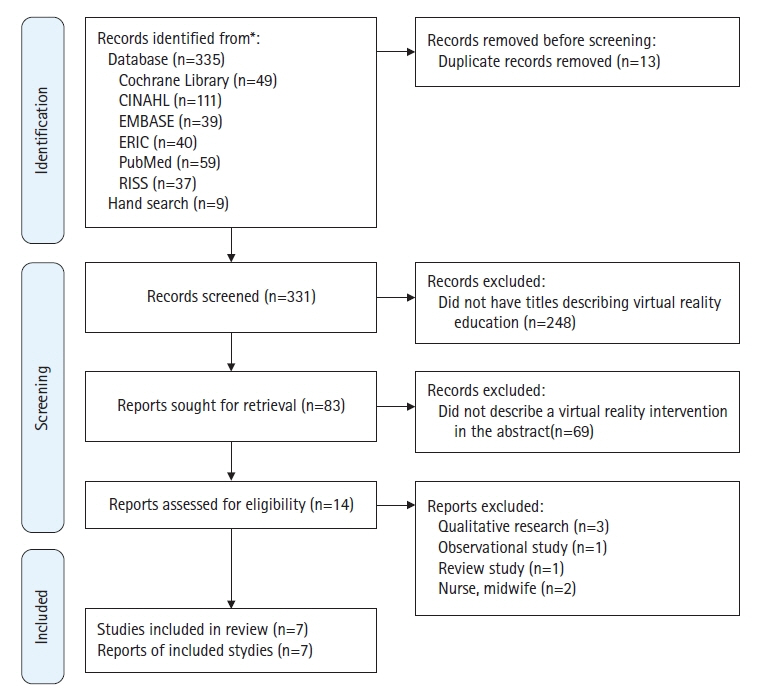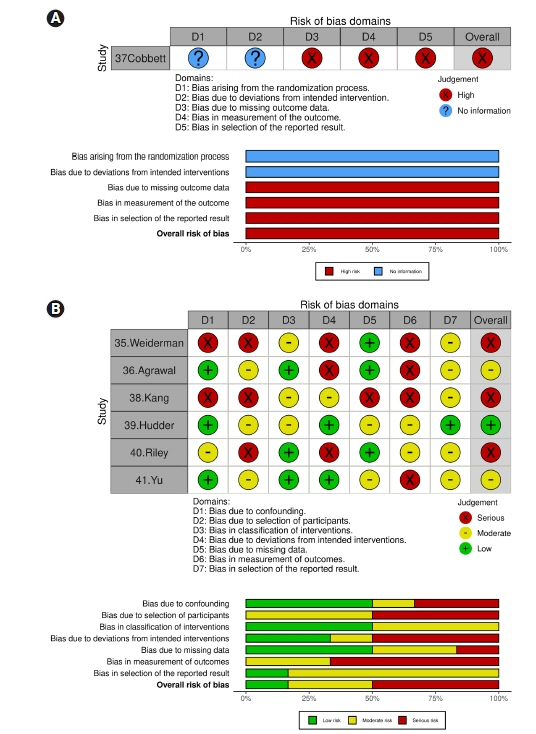Korean J Women Health Nurs.
2022 Sep;28(3):174-186. 10.4069/kjwhn.2022.09.13.
The effects of maternal-child nursing clinical practicum using virtual reality on nursing students’ competencies: a systematic review
- Affiliations
-
- 1Department of Nursing, Baekseok Culture University, Cheonan, Korea
- 2Department of Nursing, Kongju National University, Gongju, Korea
- KMID: 2535435
- DOI: http://doi.org/10.4069/kjwhn.2022.09.13
Abstract
- Purpose
This study aimed to investigate the effects of virtual reality used in maternal-child nursing clinical practicums on nursing students’ competencies through a systematic review. Methods: The inclusion criteria were peer-reviewed papers in English or Korean presenting analytic studies of maternal-child nursing practicums using virtual reality. An electronic literature search of the Cochrane Library, CINAHL, EMBASE, ERIC, PubMed, and Research Information Sharing System databases was performed using combinations of the keywords “nursing student,” “virtual reality,” “augmented reality,” “mixed reality,” and “virtual simulation” from February 4 to 15, 2022. Quality appraisal was performed using the RoB 2 and ROBINS-I tools for randomized controlled trials (RCTs) and non-RCTs, respectively. Results: Of the seven articles identified, the RCT study (n=1) was deemed to have a high risk of bias, with some items indeterminable due to a lack of reported details. Most of the non-RCT studies (n=6) had a moderate or serious risk of bias related to selection and measurement issues. Clinical education using virtual reality had positive effects on knowledge, skills, satisfaction, self-efficacy, and needs improvement; however, it did not affect critical thinking or self-directed learning. Conclusion: This study demonstrated that using virtual reality for maternal-child nursing clinical practicums had educational effects on a variety of students’ competencies. Considering the challenges of providing direct care in clinical practicums, virtual reality can be a viable tool that supplements maternal-child nursing experience. Greater rigor and fuller reporting of study details are required for future research.
Keyword
Figure
Cited by 1 articles
-
Effects of a virtual reality simulation integrated with problem-based learning on nursing students’ critical thinking ability, problem solving ability, and self-efficacy: a non-randomized trial
Young A Song, Minkyeong Kim
Korean J Women Health Nurs. 2023;29(3):229-238. doi: 10.4069/kjwhn.2023.09.12.
Reference
-
References
1. Nam CM, Kim CW, Hong K, Cho C, Hong J. A study on the learner characteristics in virtual reality by a school level curriculum. J Korean Assoc of Inform Educ. 2020; 24(1):71–78. https://doi.org/10.14352/jkaie.2020.24.1.71.
Article2. Nesenbergs K, Abolins V, Ormanis J, Mednis A. Use of augmented and virtual reality in remote higher education: a systematic umbrella review. Educ Sci. 2021; 11(1):8. https://doi.org/10.3390/educsci11010008.
Article3. Schutte DL, Kisting M, Warren C, Stoneman M. Linking hospitals to communities through evidence-based practice. Clin Nurse Spec. 2022; 36(5):249–253. https://doi.org/10.1097/NUR.0000000000000695.
Article4. Kwak KH, Choi HM, Hwang SW. The development and application of the alternative clinical practicum program for the delivery room and the newborn nursery in the non-face-to-face distance education environment. J Korean Nurs Res. 2021; 5(3):49–61. https://doi.org/10.34089/jknr.2021.5.3.49.
Article5. Kim JS, Lee AR, Eo Y. Clinical practice performance according to type of practices and satisfaction of clinical practice in students at child health nursing. J Korean Acad Soc of Nurs Educ. 2013; 19(4):542–548. https://doi.org/10.5977/jkasne.2013.19.4.542.
Article6. Kim UO, Brousseau DC, Konduri GG. Evaluation and management of the critically ill neonate in the emergency department. Clin Ped Emerg Med. 2008; 9(3):140–148. https://doi.org/10.1016/j.cpem.2008.06.003.
Article7. Park SA, Kim HY. Development and effects of a labor nursing education program using a high-fidelity simulator for nursing students. Korean J Women Health Nurs. 2020; 26(3):240–249. https://doi.org/10.4069/kjwhn.2020.09.18.
Article8. Park HJ, Lee SH. Development and effects of integrated simulation program (maternal-child) for nursing students. Child Health Nurs Res. 2015; 21(4):293–301. https://doi.org/10.4094/chnr.2015.21.4.293.
Article9. Choi EJ. Strategies of pediatric nursing clinical practice in ontact era. J Korean Nurs Res. 2020; 4(4):29–40. https://doi.org/10.34089/jknr.2020.4.4.29.
Article10. Kim Y, Kim WJ, Min H. Nursing students’ experiences in virtual simulation practice. Korean Acad Soc Nurs Edu. 2020; 26(2):198–207. https://doi.org/10.5977/jkasne.2020.26.2.198.
Article11. Fukada M. Nursing competency: definition, structure and development. Yonago Acta Med. 2018; 61(1):1–7. https://doi.org/10.33160/yam.2018.03.001.
Article12. Labrague LJ, McEnroe-Pettite D, Tsaras K, D'Souza MS, Fronda DC, Mirafuentes EC, et al. Predictors of evidence-based practice knowledge, skills, and attitudes among nursing students. Nurs Forum. 2019; 54(2):238–245. https://doi.org/10.1111/nuf.12323.
Article13. Ha YO, Kwon SJ, Kim J, Song JH. Effects of nursing skills practice using VR (virtual reality) on competency and confidence in nursing skills, learning self-efficacy, and satisfaction of nursing students. Indust Converg Res. 2022; 20(4):47–55. https://doi.org/10.22678/JIC.2022.20.4.047.
Article14. Kim MG, Kim HW. The effects of classes using virtual reality simulations of the hospital environment on knowledge of the hospital environment, academic self-efficacy, learning flow, educational satisfaction and academic achievement in nursing students. J Korean Acad Fundam Nurs. 2021; 28(4):520–529. https://doi.org/10.7739/jkafn.2021.28.4.520.
Article15. Lim JH. The effect of virtual reality simulation education on nursing process competency. J Digit Converg. 2021; 19(9):401–409. https://doi.org/10.14400/JDC.2021.19.9.401.
Article16. Kim S, Kim MJ. Effect of learner-centered virtual reality simulation education. J Digit Converg. 2022; 20(4):705–713. https://doi.org/10.14400/JDC.2022.20.4.705.
Article17. Kim YJ. Development and application of scenario-based admission management VR contents for nursing students. J Korea Soc Comput Inf. 2021; 26(1):209–216. https://doi.org/10.9708/jksci.2021.26.01.209.
Article18. Chen FQ, Leng YF, Ge JF, Wang DW, Li C, Chen B, et al. Effectiveness of virtual reality in nursing education: meta-analysis. J Med Internet Res. 2020; 22(9):e18290. https://doi.org/10.2196/18290.
Article19. Padilha JM, Machado PP, Ribeiro A, Ramos J, Costa P. Clinical virtual simulation in nursing education: randomized controlled. J Med Internet Res. 2019; 21(3):e11529. https://doi.org/10.2196/11529.
Article20. Shorey S, Ng ED. The use of virtual reality simulation among nursing students and registered nurses: a systematic review. Nurs Educ Today. 2021; 98:104662. https://doi.org/10.1016/j.nedt.2020.104662.
Article21. Page MJ, Moher D, Bossuyt PM, Boutron I, Hoffmann TC, Mulrow CD, et al. PRISMA 2020 explanation and elaboration: updated guidance and exemplars for reporting systematic reviews. BMJ. 2021; 372:n160. https://doi.org/10.1136/bmj.n160.
Article22. Higgins JPT, Thomas J, Chandler J, Cumpston M, Li T, Page MJ, Welch VA. Cochrane handbook for systematic reviews of interventions, version 6.3 (updated 2022 Feb) [Internet]. Cochrane, 2022 [cited 2022 Mar 22]. Available from: www.training.cochrane.org/handbook.23. Kim SY, Park DA, Seo HJ, Shin SS, Lee SJ, Lee M, et al. Health technology assessment methodology: systematic review. Seoul: National Evidence-based Healthcare Collaborating Agency;2020.24. Bidwell S, Jensen MF. E-text on Health Technology Assessment (HTA) information resources. Chapter 3: Using a search protocol to identify sources of information: The COSI model (updated 2003 Jun) [Internet]. Bethesda, MD: U.S. National Library of Medicine; 2003 [cited 2019 Aug 20]. Available from: https://www.nlm.nih.gov/archive/20060905/nichsr/ehta/chapter3.html#COSI.25. Sterne JA, Hernán MA, Reeves BC, Savović J, Berkman ND, Viswanathan M, et al. ROBINS-I: a tool for assessing risk of bias in non-randomised studies of interventions. BMJ. 2016; 355:i4919. https://doi.org/10.1136/bmj.i4919.
Article26. Sterne JA, Savović J, Page MJ, Elbers RG, Blencowe NS, Boutron I, et al. RoB 2: a revised tool for assessing risk of bias in randomised trials. BMJ. 2019; 366:l4898. https://doi.org/10.1136/bmj.l4898.
Article27. McGuinness LA, Higgins JP. Risk-of-bias VISualization (robvis): an R package and Shiny web app for visualizing risk-of-bias assessments. Res Synth Methods. 2021; 12(1):55–61. https://doi.org/10.1002/jrsm.1411.
Article28. Weiner E, Gordon J, Rudy S, McNew R. Expanding virtual reality to teach ultrasound skills to nurse practitioner students. Stud Health Technol Inform. 2019; 264:893–897. https://doi.org/10.3233/SHTI190352.
Article29. Jeon J, Kim JH, Choi EH. Needs assessment for a VR-based adult nursing simulation training program for Korean nursing students: a qualitative study using focus group interviews. Int J Environ Res Public Health. 2020; 17(23):1–18. https://doi.org/10.3390/ijerph17238880.
Article30. Kim MJ, Kang HS, De Gagne JC. Nursing students’ perceptions and experiences of using virtual simulation during the COVID-19 pandemic. Clin Simul Nurs. 2021; 60:11–17. https://doi.org/10.1016/j.ecns.2021.06.010.
Article31. Hardie P, Darley A, Carroll L, Redmond C, Campbell A, Jarvis S. Nursing & midwifery students’ experience of immersive virtual reality storytelling: an evaluative study. BMC Nurs. 2020; 19:78. https://doi.org/10.1186/s12912-020-00471-5.
Article32. Tolarba JE. Virtual simulation in nursing education: a systematic review. Int J Nurs Edu. 2021; 13(3):48–54.33. Claman FL. The impact of multiuser virtual environments on student engagement. Nurs Educ Pract. 2015; 15(1):13–16. https://doi.org/10.1016/j.nepr.2014.11.006.
Article34. Umoren R, Bucher S, Hippe DS, Ezenwa BN, Fajolu IB, Okwako FM, et al. eHBB: a randomised controlled trial of virtual reality or video for neonatal resuscitation refresher training in healthcare workers in resource-scarce settings. BMJ Open. 2021; 11(8):e048506. https://doi.org/10.1136/bmjopen-2020-048506.
Article35. Weideman YL, Culleiton AL. Innovation center a virtual pregnancy for pre-licensure nursing students: nine months up and close. Nurs Educ Perspect. 2014; 35(6):410–413. https://doi.org/10.5480/11-601.1.
Article36. Agrawal N, Kumar S, Balasubramaniam SM, Bhargava S, Sinha P, Bakshi B, et al. Effectiveness of virtual classroom training in improving the knowledge and key maternal neonatal health skills of general nurse midwifery students in Bihar, India: a pre- and post-intervention study. Nurs Educ Today. 2016; 36:293–297. https://doi.org/10.1016/j.nedt.2015.07.022.
Article37. Cobbett S, Snelgrove-Clarke E. Virtual versus face-to-face clinical simulation in relation to student knowledge, anxiety, and self-confidence in maternal-newborn nursing: a randomized controlled trial. Nurs Educ Today. 2016; 45:179–184. https://doi.org/10.1016/j.nedt.2016.08.004.
Article38. Kang SJ, Hong CM, Lee H. The impact of virtual simulation on critical thinking and self-directed learning ability of nursing students. Clin Simul Nurs. 2020; 49:66–72. https://doi.org/10.1016/j.ecns.2020.05.008.
Article39. Hudder K, Buck-McFadyen E, Regts M, Bushuk K. A quasi-experimental study comparing virtual simulation to lab-based learning of newborn assessment among nursing students. Clin Simul Nurs. 2021; 55:59–66. https://doi.org/10.1016/j.ecns.2021.04.002.
Article40. Riley E, Capps N, Ward N, McCormack L, Staley J. Maintaining academic performance and student satisfaction during the remote transition of a nursing obstetrics course to online instruction. Online Learn. 2021; 25(1):220–229. https://doi.org/10.24059/olj.v25i1.2474.
Article41. Yu M, Yang M, Ku B, Mann JS. Effects of virtual reality simulation program regarding high-risk neonatal infection control on nursing students. Asian Nurs Res (Korean Soc Nurs Sci). 2021; 15(3):189–196. https://doi.org/10.1016/j.anr.2021.03.002.
Article42. Singh HK, Joshi A, Malepati RN, Najeeb S, Balakrishna P, Pannerselvam NK, et al. A survey of E-learning methods in nursing and medical education during COVID-19 pandemic in India. Nurs Educ Today. 2021; 99:104796. https://doi.org/10.1016/j.nedt.2021.104796.
Article
- Full Text Links
- Actions
-
Cited
- CITED
-
- Close
- Share
- Similar articles
-
- The digital literacy, awareness, and educational needs of virtual reality among nursing students
- A Phenomenological Study on the Experiences of Nursing Students' Communication in Clinical Nursing Practicum
- Effects of a Virtual Reality Simulation and a Blended Simulation of Care for Pediatric Patient with Asthma
- Development of a virtual reality program in South Korea for the measurement of vital signs in children: a methodological study
- Nursing students’ satisfaction and clinical competence by type of pediatric nursing practicum during the COVID-19 pandemic



